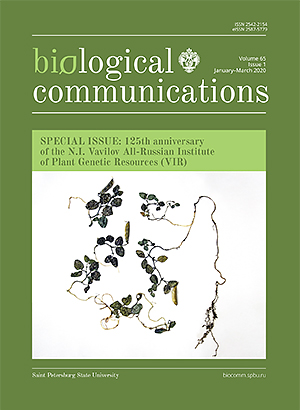Results of studying wild relatives of the cultivated plants of Russia
DOI:
https://doi.org/10.21638/spbu03.2020.104Abstract
Issuing specific recommendations on the in situ conservation of wild relatives of cultivated plants (=crop wild relatives, CWR) in Russia is possible only on the basis of preliminary comprehensive studies of their composition, structure and features. N.I. Vavilov was the founder of comprehensive studies of cultivated plant relatives. O.N. Korovina was the first to substantiate the basic principles of conserving CWR diversity in their natural habitats, and to suggest choosing the most suitable conservation measures, taking into account the data on the distribution area of a taxon, the state of habitat condition, the state of the taxon in nature, and human influence. The current phase of studying CWR diversity and developing a domestic strategy for its conservation is associated with geopolitical changes in this country, and with the inclusion of research performed at VIR on CWR diversity in situ conservation into large-scale international projects. The fundamental conditions for attributing a wild species to relatives of cultivated plants are, first, taxonomic or evolutionary and genetic closeness to a cultivated species, and second, the use of species in breeding, or the potential introduction of a species into cultivation. The work on the compendium of wild relatives of cultivated plants of Russia is still far from completion. As a result of the inventory, a list of 1701 species of relatives of cultivated plants for food and agriculture was compiled. The largest number of species (965) grows in the European part of Russia. The Russian Caucasus ranks second in terms of CWR richness (956 species), and the third in CWR numbers is the Russian Far East (598 species). The 102 nature reserves included in the study contain 1363 CWR species. The CWR diversity is most effectively conserved in the nature reserve network of the Russian Far East and Eastern Siberia, and least of all in the nature reserves of the Russian Caucasus, despite the significant concentration of CWR species in this region.
Keywords:
wild relatives of cultivated plants, crop wild relatives (CWR) of Russia, plant genetic resources (PGR), in situ conservation, Red Books, specially protected natural areas (SPNA)
Downloads
References
Downloads
Published
How to Cite
License
Articles of Biological Communications are open access distributed under the terms of the License Agreement with Saint Petersburg State University, which permits to the authors unrestricted distribution and self-archiving free of charge.





